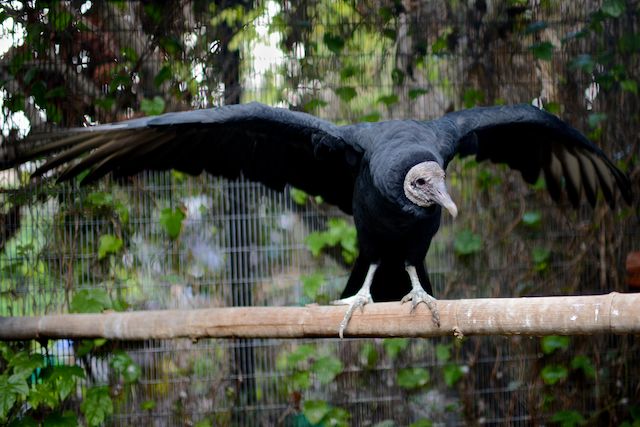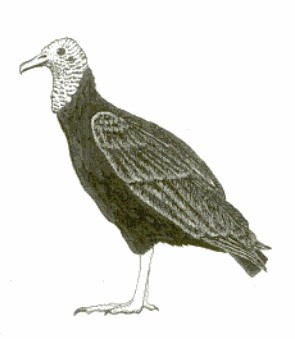One of the great pleasures of driving around the American south-west is the variety of raptors – birds of prey – that present themselves as you cruise the big-sky country. Perched on trees and power-poles, soaring high on thermals or just hanging around looking for the dead or dying. They are out there, you’ve just got to use that inquisitive and following eye to find them.
I had a look at one of the most common American raptors, the Turkey Vulture (Cathartes aura), back in 2009 here. This week’s bird is the Turkey Vulture’s less common cousin, the Black Vulture (Coragyps atratus) and I caught up with this 40 year-old bird – and his 30 year-old female companion – in the back-yard aviary of my friend and respected ethnoornithologist Amadeo Rea from the University of San Diego at his house there a few weeks ago.
You can learn more about Amadeo’s magisterial ethnobiological work with the Piman peoples at the University of Arizona Press page here.
Amadeo has looked after these birds since they were fledglings as part of his long-term research into the relationships between human and birds in the American south and south-west.
Black Vultures rely on sight than smell when searching for food and will often follow a Turkey Vulture towards carrion, where they can gather in large flocks – often of several hundred birds – around a carcass. Black Vultures have stronger beaks than their cousins and can tear up carcasses more easily and will take a wider variety of food, including vegetable and fruits like over-ripe coconuts, pumpkins and oil-palm nuts.
Black Vultures are less than graceful when not in flight. Take-offs and landings can be clumsy, comical affairs and when on the ground they hop like – albeit very large – domestic chooks. Here is how Amadeo described their habits on the ground in his loving examination of the species in The Raptors of Arizona (1998, Richard L. Glinski, Arizona. Game and Fish Dept.):
In contrast to the Turkey Vulture, Black Vultures seem quite content on the ground, often running about in the open where other birds might fly instead. At leisure the Black Vulture walks with a peculiar gait, the rear bouncing with each step. When more hurried the bird “gallops,” with the tail angled up, the head lowered and the body held more horizontally. When moving even faster, especially when chasing another vulture, the bird may extend its wings during the “gallop” before sailing into the air.
…
The anatomy of the Black Vulture has evolved for social feeding at larger carcases. The long legs are poorly adapted for pinning down small rodents or reptiles so that they can be torn up with the bill, a feat at which the Turkey Vulture excels. The Black Vulture, in contrast, is adapted for feeding melees at which the birds thrust, jab and spring about a large carcass. Even when housed in captivity, without competition from other scavengers, a Black Vulture will gobble down its food to repletion in moments.
Black Vultures are economically and culturally important throughout their extensive range of the southern United States, Mexico, Central America and most of South America. Black Vultures are usually locally resident though birds in the cooler northern regions may undertake short sseasonal migrations.
In her valuable essay exploring the extensively documented human – vulture associations, “The Vulture: The Sky and the Earth,” Elizabeth P. Benson says the following of Black Vultures:
The black vulture particularly tends to live close to humans and their waste. Vultures lack feathers around their heads and legs, where they have contact with carrion and feces, so the ultraviolet rays of the sun come down directly on their flesh, discouraging bacteria and parasites. Vultures spread their wings after feeding and the sun disinfects them.
Their digestive system is so remarkable that the ejecta may kill germs. Moreover, vultures make the environment healthy (see Reichel-Dolmatoff 1985, II:132; Salinas Pedraza and Bernard 1978:132).
They turn the vile into something white that glistens in the sun.
In a Chorti Maya narrative, the black vulture is a mason with lime on his apron (Fought 1972:180-181). He boasts that he can make lime and that the white houses in the town look beautiful and he alone has plastered them. Vultures make dark things bright. They are associated not only with death but with transformation of the dead.
…
Vultures have been called masters of two disciplines: soaring and sanitation (Dunne et al. 1988:136). In towns, villages, and rural communities where there is no modern plumbing or garbage disposal, they provide the only sanitation services. “They eat anything, but especially they like the shit,” observed a worker in a slaughterhouse in Guatemala, who also noted that the vultures showed up only on Thursdays and Saturdays, the two days of slaughter (Maslow 1986:200).
Me, I’ll be back in the States in mid-May, eyes cast as ever skyward.









Crikey is committed to hosting lively discussions. Help us keep the conversation useful, interesting and welcoming. We aim to publish comments quickly in the interest of promoting robust conversation, but we’re a small team and we deploy filters to protect against legal risk. Occasionally your comment may be held up while we review, but we’re working as fast as we can to keep the conversation rolling.
The Crikey comment section is members-only content. Please subscribe to leave a comment.
The Crikey comment section is members-only content. Please login to leave a comment.